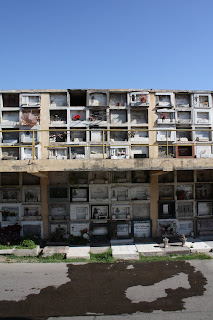
I live with two dogs. One is a basset hound named Leo who is a bastard. Adorable, but still a bastard. He urinates on most walls and corners of the kitchen and living room, goes b.m. on the patio next to where I dry my clothes, barks all day long and cries and moans if he isn't showered with affection.
There is a chair placed in front of the refrigerator, which is fastened shut by a velcro strap on its door, in efforts to deter the animal from his routine rummage through the leftovers and perishable provisions placed on the lower shelves. When these tactics don't work, Leo gets a stern, "Leo...what are we going to do with you?" talk from my roommate and a pop on the bottom, which the dog shrugs off and then runs into my roommate's bed where he licks his chops for extra tomato sauce or cilantro before taking a nice nap under the blankets.
The other dog doesn't have it quite as nice as Leo. He's a stray that has chosen my street as his best option for residence. I see him either lying on the sidewalk, scampering off down an alley or trying to follow me into my house about every day.
He's lost about a quarter of his hair, sleeps in trash piles at the end of my street and can barely open his eyes or wag his tail. Sometimes I see him in the morning nursing fresh wounds from battles the night before. Lately he's been wearing a blue dog sweater that some kind soul has donated to help him get through the dreary Santiago winter.
Unfortunately, the dog needs a lot more than a sweater and he is not alone.
The stray dogs in Santiago are some of the most eminent, depressing and reverberating blemishes on the capital city's streets. Downtrodden, malnourished, limping and sick, the pooches roam parks, sidewalks, plazas and marketplaces looking for food, shelter or a scratch on the head. The big ones who've been on the block for a while (because only the strong survive) dominate their domains, while the little guys scurry off in search of neutral territory, which usually means foodless territory.
They eat scraps out of trash cans, chase cars and bark at hubcaps (maybe they've lost a friend under the crunch of a taxi's tire and are trying to get even) and plunge their noses in tourists' pockets looking for lunch.
The pups that spent the previous night fighting for their lives lick their scrapes as the overfed bulldog saunters by with a new manicure on a walk with its owner through the park. They probably think, "You wouldn't last a week out here
mamón." And you know what? They're probably right.
The clean-up crews work surprisingly fast and roadkill and remains of the defeated are rarely seen on the streets. Like they're sweeping 'em under a rug before the visitors walk by.
Most people are decent human beings and either verbally acknowledge the strays, glance at them, throw them a scrap or walk by felling sorry for them. Other less-caring individuals yell, chase, smack or brush them out of the way.
Granted, some of these dogs can be trouble and I can see why a business wouldn't want a bunch of stray dogs hanging around the storefront. But that's one thing. It's another thing entirely when they are kicked with steel-toe'd boots by drunken thugs, smacked with sticks or driven out to the countryside and dropped off to fend for themselves.
Coming from a family that has a history of volunteering at the humane society, postponing appointments to stop and pick up strays and worshiping its three canine members, this kind of treatment and environment is unnerving at best.
There are ways to help, but it's not as easy to make a dent in the problem like we do back home. A group of us recently helped out at a
dog shelter in Melipilla, a town about an hour away from Santiago. Surprise surprise, most dog shelters in Santiago receive little/no government funding and survive solely on donations.
The conditions were startling. About 70 dogs living in an area a bit bigger than a basketball court. There wasn't much grass and the shelters were made from scraps of wood and chicken wire. We shoveled shit, cleaned the kennels, bathed, fed and played with the dogs for an entire Sunday afternoon. It felt nice to help out, but I left feeling like we could have done more. We're planning another visit in July and hope to build some new kennels for the dogs.
Don't get me wrong, the dogs in the shelter have it a lot better than those on the streets, but there is still much work to do.
One of the main problems, similar to the case with Leo, is the people. Many get bored or frustrated with their pets and discard them like an old toy. In addition, there is no push to get people to spay/neuter their pets, the cost of such procedures is pricey, leaving most dogs fully in tact, raring and ready to litter.
There are organizations working to combat these problems, but something so ingrained in such a polarized society is not easily remedied. It takes a lot to shorten the drop off from Leo's pillow on his balcony in the sun to my stray friend's spot on the sidewalk below.
----
- Protectora de Animales San Francísco de Asís
Phone: Monica Cuevas: 765 919 60
monicuevaslara@hotmail.com
- Humane Society International:
http://www.hsus.org/hsi/- Agrupación Cultural Amor a Los Animales (ACUAA)
Esperanza 475 El Bosque
SANTIAGO, Región Metropolitana
Tel: + 56 (2) 5277 026
csprohnle@terra.cl
- Coalición por el Control Ético de la Fauna Urbana (CEFU):
http://www.cefu.cl/joomla/- Organización por la Protección y Respeto para los Animales (OPRA):
www.oprachile.cl- Somos Perritos:
www.somosperritos.cl- Teleton de los Animales Chile:
http://teletonanimales.oamm.info/



































